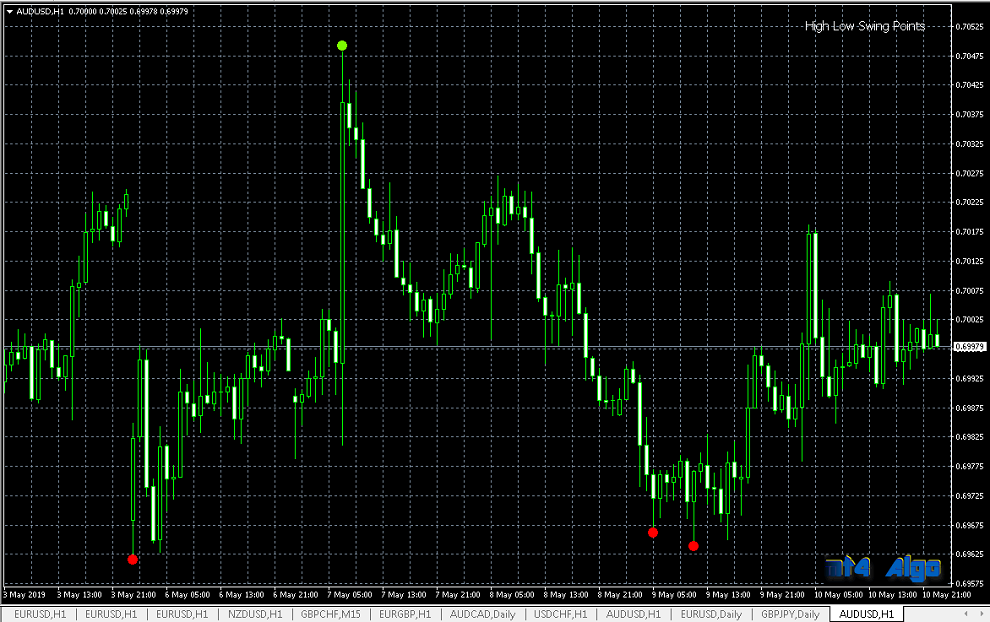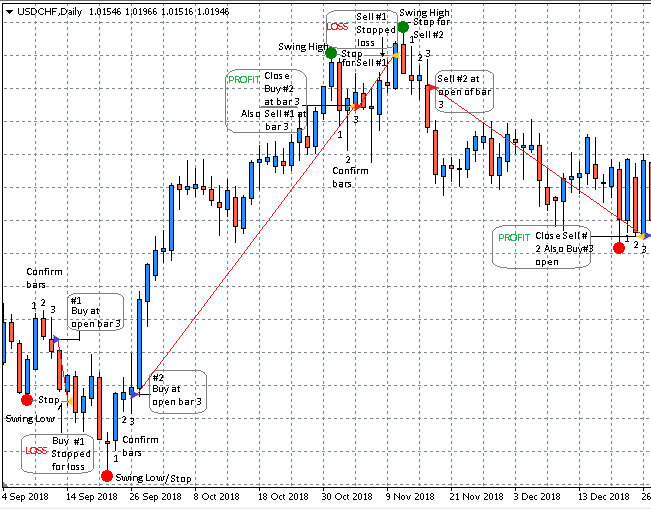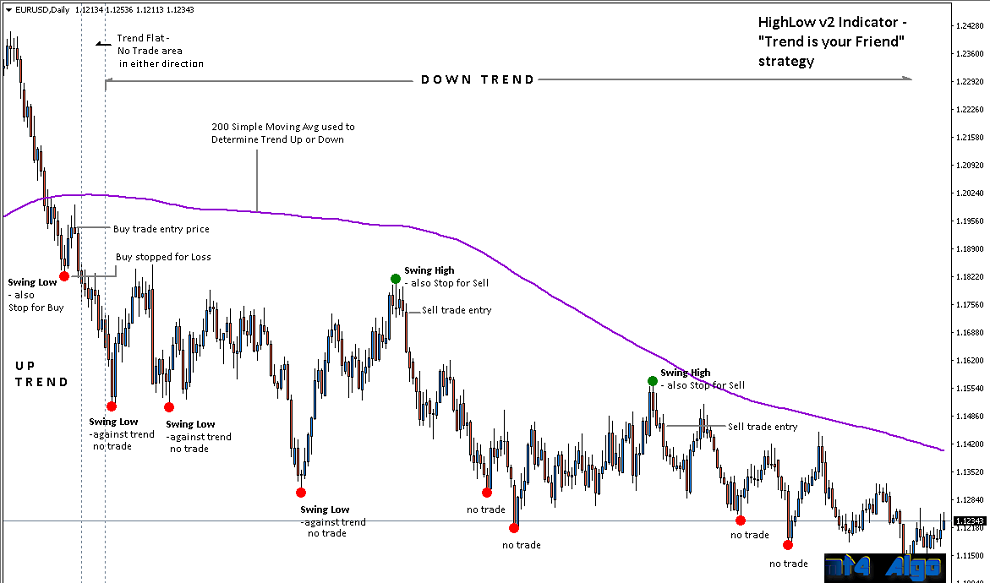
<click to enlarge>
Purpose:
To mark Price Swing Points on a chart (WILL NOT REPAINT). Version 2 includes the ability to generate alerts to the screen and to send Notifications to ones smartphone*.
*(requires installation of Metatrader app on your phone and configuration of your Metatrader platform that is running the indicator)
Inputs:
- BarsPreceding – number of consecutive bars preceding a bar that must have lower highs (for swing High points) or must have higher lows (for swing Low points).
- ConfirmBars – number of bars following the swing bar that must have lower highs (for Swing High points) or must have higher lows (for Swing Low points).
- Space – controls how far the Swing High and Swing Low dots will be drawn from the price bars. It is a number of pips between the Swing High or Low dot marking the bar and the bar itself.
- BarThickness – controls how heavy a dot is used to mark the Swing High and Swing Low bars.
- HighColor – Swing High bars will be marked with a dot of this color.
- LowColor – Swing Low bars will be marked with a dot of this color.
- UseAlerts – If true, Chart alerts and Texts will be generated for any Swing points found.
User Notes:
One of the “Holy Grails” of indicators is to find one that can mark Swing High and Swing Low bars without “repainting”. Repainting is where an indicator will mark a bar with a graphical symbol and then some bars later move (repaint) or remove the symbol. The internet is full of spectacular pictures of indicators marking Swing Highs and Lows perfectly. Not until one actually runs an indicator do they become aware of the repainting that often takes place.
Since no Swing point indicator can possibly know whether a Swing High or Low is going to be surpassed in the future, this is always unavoidable if you are marking the just-closed price bar as a swing high or low bar. The same problem affects the Zig Zag indicator and other indicators of that ilk.
To better handle this, the HighLow indicator requires that the three bars immediately following a bar must be lower than that bar in the case of a Swing High bar and Higher than that bar in the case of a Swing Low bar. Of course, while the HighLow indicator will not repaint, the trade-off is that the HighLow indicator will not mark bars until three bars after a Swing bar. So there is some lag that must be tolerated. Also, same direction swing points can appear as early as 4 bars later. However as prices typically retrace, the indicator can still be useful to the patient trader and signals given may be better confirmed by other indicators or price action at a later time.
The BarsPreceding input is the most critical input. The larger this number the more significant are the Swing points that get identified.
In this version 2 of the indicator users have the ability to turn on Alerting and Text messages* to ones Smartphone.
Version 2 also gives the user control over the number of Confirm bars required. While the Original version requires 3 bars (2 closed bars and the opening price of the bar currently open at the time a Swing point is recognized), version 2 lets the user reduce or extend the number of Confirm bars. For a quicker recognition of a Swing point, Confirm bars may be reduced all the way down to just 1 bar (the opening price of the current bar at the time a Swing point is recognized). For a more profound recognition, Confirm bars may be increased.
Version 2 also improves the internal structure of the code.
Strategies / Tips:
Reversal Play
One possible play treats the Swing point as a reversal point and then to set your stop at the swing point price. When doing this strategy I like to use a BarsPreding value of 48 or higher and then look for the 2nd or 3rd Swing point that is against the current trend.

(click to enlarge)
Your exit will be at a fixed take profit, or when an opposite reversal point is recognized.
Pending Limit orders = Better Entry prices
Because the HighLow Indicator requires Confirming bars, using market orders means you will necessarily miss the exact High or Low point. Those wanting optimal entry price may want to use a Pending Limit order at the Swing point and hope the price retraces to it; which often happens.
In this way, you will get a better entry price. In addition, you’re using Limit orders, so you don’t have to feel rushed to get a market trade placed. Of course, traders using Pending Limits orders risk missing a reversal, Also, you will use something other than the swing point price as your stop loss as that will now be your entry price.
“Trend is your Friend” play
According to the well-known phrase, this strategy seeks to trade with the trend (always a wise choice). With this play, once you’ve identified a trend that you want to take advantage of, you will use the HighLow indicator with a relatively smaller BarsPreceding input value.
With a smaller BarsPreceding input you are more likely to be notified of Swing points that are with-the-trend. You will then use these minor with-the-trend swing points as your trade entry points.
Forex currency pairs often accommodate trading with the trend as unlike equities, trends often go on for extended periods of time. In addition for such trends, you don’t have to get in on the very beginning of the trend.

(click to enlarge)
Let your Profits run by Updating your Stop
If you’re lucky enough to find yourself in a trend and have a trade floating a profit. Rather than taking that profit you might want to try and accumulate more profit while incrementally locking in a portion of those profits by updating(trailing) your stop.
However, rather than updating your stop with every pip like a generic Trailing stop, the HighLow indicator can help you pick meaningful prices to update your stop to.
Once you have a trade that is floating a profit and the market is trending in your favor, run the HighLow indicator with a “smallish” BarsPreceding input. This will allow the HighLow indicator to identify the more minor swing points. These often make intelligent places to update your stop to
For example, In an Up trend, you will notice a pattern of Higher Highs and High Lows. Suppose you have a Buy trade floating a nice profit. You can use the progressively higher Swing Low Points as intelligent prices to update your stop to.
System Requirements
To run Metatrader 4 you should be using Windows 2000 or later, with a 2.0 GHz or faster CPU, and at least 512 MB RAM (although 1 GB is recommended). You should have a screen resolution of 1024 x 768 or higher, and an internet connection speed of 56 kbps or faster.